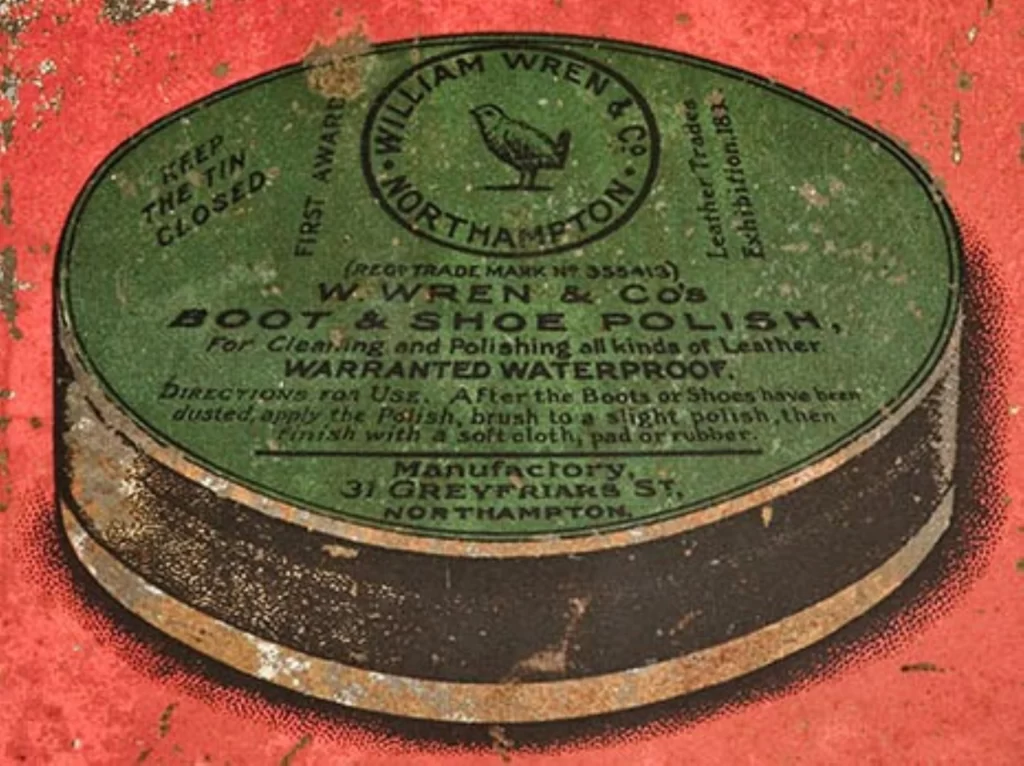
It is no surprise that Northampton being the focus of the boot and shoe industry in the 19th century would also be the focus of the success of products in related industries. One of those was Wren’s boot polish and dubbin. The “Wren” name was synonymous with shoe polish well after WW2. Its origins are with its inventor William Edward Wren.
William Edward Wren was born in 1846 in Merton, Surrey and after a time in the Navy married Marlborough-born Sarah Hobbs in Portsea in 1870. In 1871 and 1881 they were recorded as living in Camberwell, Surrey. The 1891 census shows William Wren as a Heel Ball maker at 31 Grey Friars Street, Northampton along with his wife Sarah and their five children: daughter Mary C. E. aged 19, a boot machinist, born in Camberwell Surrey; son William E. aged 10, born in Camberwell Surrey; daughter Edith A. aged 8, born in Camberwell Surrey; son Thomas D, aged 5, born in Northampton; Jenny aged 3, also born in Northampton. We can conclude they had moved to Northampton in 1885 or earlier. Grey Friars Street was demolished in the 1970s and lies on the site of the former Greyfriars Bus Station, also now demolished.
The 1901 census lists the family as having moved out from ‘above the shop’ to a large terraced house at 26 Margaret Street just three streets away from the works, the other side of the prison. It has William E Wren described as Wax Refiner (Grease) employer, his wife still alive at the age of 51, their 29-year-old daughter Mary as a nurse, 20-year-old son William as an Imperial Yeoman, and Edith, Thomas and Jenny still at home.

Whilst at 31 Grey Friars Street in 1889 William Wren invented what we know today as boot and shoe polish. It was awarded the First Award from the Leather Trades Exhibition in 1892 held at the Royal Agricultural Hall, Ilsington, London. Building on this success, William Wren soon branched into other products like Floor & Furniture Polish, Saddle & Harness Paste, as well as Lavendo Furniture Polish.

In 1928 Wren’s had three premises in Northampton: 31 Grey Friars Street, 6 Albert Street (adjacent to Grey Friars Street) and Bull Head Lane, west of Sheep Street.
In 1938 the business was finally acquired by Chiswick Products Ltd which also owned Meltonian (E. Brown & Son) Limited. By 1942 production transferred from Northampton to the company’s factory at Watford.
From the beginning of the 20th century, Wrens became almost synonymous with the Royal Family in England. During the reign of King Edward VII, Wren’s advertisement for its Boot & Shoe Polish in 1908 appeared with the declaration “As used by all branches of His Majesty’s Service”. Its reputation reached a new peak when King George VI emulated his grandfather by awarding the Royal Warrant to Wren’s after its acquisition by Chiswick Polish Co. It is understood to have remained the boot polish of choice by the British Army during WW2.
A sad sequel
After the death of founder William Wren in 1915 the business passed to his sons William Edward Wren and Thomas Duncan Wren. For a while, things seemed to proceed well for the business and Thomas Duncan acquired The Poplars1 on the Barrack Road, Northampton whilst his brother William lived at The Poplars in Earls Barton.

During the First World War Thomas Wren became involved in two incidents between himself and a business and billiards associate Louis Steinberg who Thomas assumed was of German origins (he was Russian, but born in what is today Latvia) and doubted his loyalty to Great Britain. The first incident involved a fracas at The Grand Hotel, and the second occasion in 1918 Wren made libellous and offensive comments about Steinberg. The first incident resulted in a fine of 20 shillings (£1) and the second had damages of £250 awarded against him.
A later legal case in 1921 however puts Thomas Wren in a different light. A resident of Semilong Road was accused of detaining one of Mr Wren’s homing pigeons (valued at £5). Thomas Wren bred homing pigeons for the Admiralty during the war and the poor fellow from Semilong Road found himself summoned under the Defence of the Realm Act and fined £5.
By 1926 things seemed to not be going so well for Thomas Wren and we find the contents of The Poplars up for sale. Thomas and his wife Kate moved to a house called “Maycroft” on the Weedon Road. About this time Thomas sold his shares in the family company and signed an undertaking not to use the name “Wren” in business.
Alas, Thomas seems to have forgotten to keep to this understanding as in 1928 he finds himself in the Chancery Division of the High Court defending himself against the current owners of William Wren and Co. for using the name “Wren’s Polishes”. An agreement was made to change the name to “Tommy’s Polishes” and to cease using green tins. This however was not the end of the story as Thomas’s business was liquidated in 1929.
Thomas slips out of the headlines (and our gaze) for the remainder of his life and died aged 64 in 1949 at 200 Abington Avenue. His wife Kate, who he married in 1909, lived in Northampton until she died in 1960.
- See Lost churches: St Bartholomew and St Lawrence for the earlier history of The Poplars house
© Copyright : Graham Ward. All rights reserved.